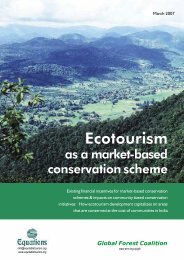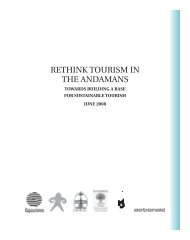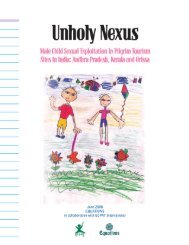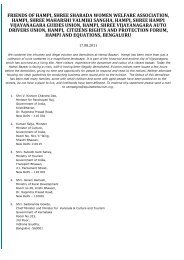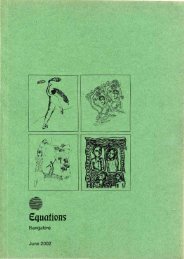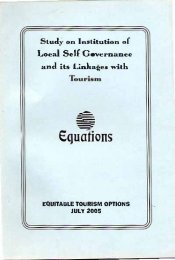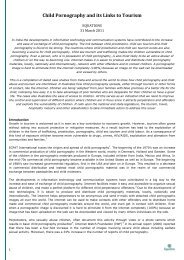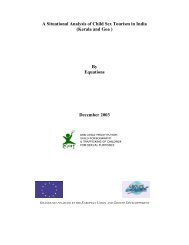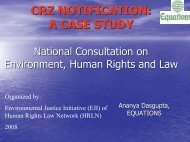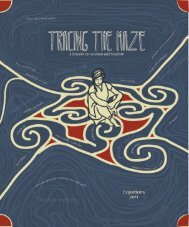Nilgiris Biosphere Reserve - Equitable Tourism Options
Nilgiris Biosphere Reserve - Equitable Tourism Options
Nilgiris Biosphere Reserve - Equitable Tourism Options
Create successful ePaper yourself
Turn your PDF publications into a flip-book with our unique Google optimized e-Paper software.
up huts was the homeland of different adivasi communities in Wayanad<br />
such as the Paniyas. the Vetta Kurumas, the Kattunaikkas. the Adiyas and<br />
the Mullukuruma etc. Our sacred groves and burial grounds still exist in<br />
Muthanga. Several adivasi families had been forcibly evicted from<br />
Muthanga during 1970s and '80s, first while declaring the area as a<br />
sanctuary and then for establishing the eucalyptus plantations. Those who<br />
were evicted were compelled to live a wretched life in several tribal<br />
'colonies' where starvation deaths were rampant.<br />
The adivasi families who entered the forestland had only sought to assert<br />
the traditional right over the Muthanga forests. They erected huts in the<br />
barren area and reorganised the Adivasi Oorukootams (hamlet-level selfgovernment<br />
institution). Along with subsistence agriculture, we re-started<br />
our gothra pooja (collective ritual worship). A minimum programme for Self<br />
Rule in accordance with the spirit of the Panchayats (Extension to the<br />
Scheduled Areas) Act, 1996 was drawn up. The regeneration of the ecosystem,<br />
primarily the water sources and the vegetation was an important<br />
objective in this. The Adivasi Oorukootams reorganised in the Muthanga<br />
were determined to achieve this through community management and the<br />
application of traditional knowledge. We were convinced that there was no<br />
need for huge donor agency funds for achieving this objective.<br />
At no point during the struggle in Muthanga, did the Govt. authorities<br />
conduct a discussion with the protestors. The authorities never issued any<br />
notice in accordance with eviction procedures. The police or the District<br />
Collector did not gather any information from us. Throughout the AGMS<br />
occupation of Muthanga, the Forest Department, however, resorted to<br />
unlawful and covert means to evict the adivasis. Twice they sent<br />
domesticated elephants fed with alcohol to attack the adivasi huts. On two<br />
occasions, some unknown persons, obviously hired by the Forest<br />
Depa rtment, set fire to the forests and the grassland.<br />
All the authorities, and a few fake conservationists with vested interests,<br />
concealed the truth regarding the actual status of the Muthanga forest and<br />
the indigenous people who had a right over it. Instead, they churned out<br />
false reports claiming that Muthanga was the breeding ground of elephants<br />
and a core area of the sanctuary. Most of the biodiversity of Muthanga had<br />
been sucked dry by a parallel economy that thrived on illegal ivory and<br />
sandalwood trade that went on unabated with the connivance of the Forest<br />
Nilagiris : Fading Glory 76



